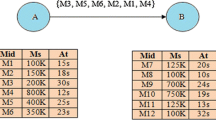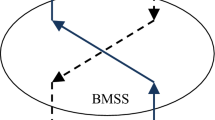Abstract
Routing protocols in delay tolerant networks usually utilize multiple message copies to guarantee the message delivery, in order to overcome unpredictable node mobility and easily-interrupted connections. A store-carry-and-forward paradigm was also proposed to further improve the message delivery. However, excessive message copies lead to the shortage of buffer and bandwidth. The spray and wait routing protocol has been proposed to reduce the network overload caused by the buffer and transmission of unrestricted message copies. However, when a node’s buffer is quite constrained, there still exist congestion problems. In this paper, we propose a message scheduling and drop strategy on spray and wait routing protocol (SDSRP). To improve the delivery ratio, first of all, SDSRP calculates the priority of each message by evaluating the impact of both replicating and dropping a message copy on delivery ratio. Subsequently, scheduling and drop decisions are made according to the priority. In order to further increase delivery ratio, we propose an improved message scheduling and drop strategy on spray and wait routing protocol (ISDSRP) through enhancing the accuracy of estimating parameters. Finally, we conduct extensive simulations based on synthetic and real traces in ONE. The results show that compared with other buffer management strategies, ISDSRP and SDSRP achieve higher delivery ratio, similar average hopcounts, and lower overhead ratio.
Similar content being viewed by others
References
Fall K. A delay-tolerant network architecture for challenged Internets. In Proc. the Conference on Applications, Technologies, Architectures, and Protocols for Computer Communications, Aug. 2003, pp.27-34.
Akyildiz IF, Akan ÖB, Chen C, Fang J, Su WL (2003) InterPlaNetary Internet: State-of-the-art and research challenges. Computer Networks 43(2):75–112
Uddin MYS, Ahmadi H, Abdelzaher T, Kravets R (2013) Intercontact routing for energy constrained disaster response networks. IEEE Transactions on Mobile Computing 12(10):1986–1998
Pentland A, Fletcher R, Hasson A (2004) Daknet: Rethinking connectivity in developing nations. Computer 37(1):78–83
Juang P, Oki H, Wang Y, Martonosi M, Peh L S, Rubenstein D. Energy-efficient computing for wildlife tracking: Design tradeoffs and early experiences with ZebraNet. In Proc. the 10th International Conference on Architectural Support for Programming Languages and Operating Systems, Dec. 2002, pp.96-107.
Xiao MJ, Wu J, Huang LS (2014) Community-aware opportunistic routing in mobile social networks. IEEE Transactions on Computers 63(7):1682–1695
Vahdat A, Becker D. Epidemic routing for partiallyconnected ad hoc networks. Technical Report CS-2000-06, Department of Computer Science, Duke University, 2000.
Spyropoulos T, Psounis K, Raghavendra C S. Spray and wait: An efficient routing scheme for intermittently connected mobile networks. In Proc. the ACM SIGCOMM Workshop on Delay-Tolerant Networking, Aug. 2005, pp.252-259.
Wang E, Yang YJ, Wu J (2015) A Knapsack-based buffer management strategy for delay-tolerant networks. Journal of Parallel and Distributed Computing 86:1–15
Lindgren A, Phanse K S. Evaluation of queueing policies and forwarding strategies for routing in intermittently connected networks. In Proc. the 1st International Conference on Communication System Software and Middleware, Jan. 2006, pp.1-10.
Kim D, Park H, Yeom I. Minimizing the impact of buffer overflow in DTN. In Proc. International Conference on Future Internet Technologies (CFI), Jan. 2008.
Li Y, Qian M J, Jin D P, Su L, Zeng L G. Adaptive optimal buffer management policies for realistic DTN. In Proc. IEEE Global Telecommunications Conference, Nov. 30-Dec. 4, 2009.
Zhang XL, Neglia G, Kurose J, Towsley D (2007) Performance modeling of epidemic routing. Computer Networks 51(10):2867–2891
Elwhishi A, Ho PH, Naik K, Shihada B (2013) A novel message scheduling framework for delay tolerant networks routing. IEEE Transactions on Parallel and Distributed Systems 24(5):871–880
Krifa A, Barakat C, Spyropoulos T. Optimal buffer management policies for delay tolerant networks. In Proc. the 5th Annual IEEE Communications Society Sensor, Mesh and Ad Hoc Communications and Networks, June 2008, pp.260-268.
Krifa A, Barakat C, Spyropoulos T. An optimal joint scheduling and drop policy for delay tolerant networks. In Proc. International Symposium on a World of Wireless, Mobile and Multimedia Networks, June 2008, pp.1-6.
Krifa A, Barakat C, Spyropoulos T (2012) Message drop and scheduling in DTNs: Theory and practice. IEEE Transactions on Mobile Computing 11(9):1470–1483
Ramiro V, Dang D K, Baudic G, P´erennou T, Lochin E. A Markov chain model for drop ratio on onepacket buffers DTNs. In Proc. the 16th International Symposium on a World of Wireless, Mobile and Multimedia Networks, June 2015.
Nishiyama H, Takahashi A, Kato N, Nakahira K, Sugiyama T (2015) Dynamic replication and forwarding control based on node surroundings in cooperative delay-tolerant networks. IEEE Transactions on Parallel and Distributed Systems 26(10):2711–2719
Niyato D, Wang P, Tan HP, Saad W, Kim DI (2015) Cooperation in delay-tolerant networks with wireless energy transfer: Performance analysis and optimization. IEEE Transactions on Vehicular Technology 64(8):3740–3754
Spyropoulos T, Psounis K, Raghavendra C S. Spray and focus: Efficient mobility-assisted routing for heterogeneous and correlated mobility. In Proc. the 5th Annual IEEE International Conference on Pervasive Computing and Communications Workshop, March 2007, pp.79-85.
Kim Y P, Koo J I, Jung E, Nakano K, Sengoku M, Park Y J. Composite methods for improving spray and wait routing protocol in delay tolerant networks. In Proc. IEEE International Symposium on Communications and Information Technologies, Oct. 2010, pp.1229-11234.
Iqbal S M A. Multischeme spray and wait routing in delay tolerant networks exploiting nodes delivery predictability. In Proc. the 15th International Conference on Computer and Information Technology, Dec. 2012, pp.255-260.
Li GW (2015) Q H, Cao G H. Forwarding redundancy in opportunistic mobile networks: Investigation elimination and exploitation. IEEE Transactions on Mobile Computing 14(4):714–727
Wang E, Yang Y J, Wu J, Liu W B. A buffer management strategy on spray and wait routing protocol in DTNs. In Proc. the 44th International Conference on Parallel Processing, Sept. 2015.
[26] Groenevelt R, Nain P, Koole G. Message delay in MANET. In Proc. International Conference on Measurement and Modeling of Computer Systems, June 2005, pp.412-413.
Keränen A, Ott J, Kärkkäinen T. The ONE simulator for DTN protocol evaluation. In Proc. the 2nd International Conference on Simulation Tools and Techniques, March 209, Article No. 55.
Abdelkader T, Naik K, Nayak A, Goel N, Srivastava V (2016) A performance comparison of delay-tolerant network routing protocols. IEEE Network 30(2):46–53
Author information
Authors and Affiliations
Corresponding author
Rights and permissions
About this article
Cite this article
Wang, E., Yang, YJ., Wu, J. et al. A Buffer Scheduling Method Based on Message Priority in Delay Tolerant Networks. J. Comput. Sci. Technol. 31, 1228–1245 (2016). https://doi.org/10.1007/s11390-016-1694-7
Received:
Revised:
Published:
Issue Date:
DOI: https://doi.org/10.1007/s11390-016-1694-7




